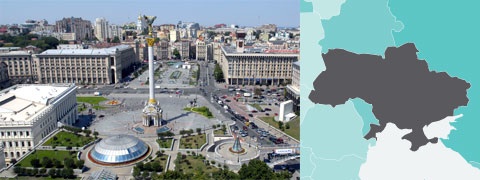Country assessments
Ukraine
- Details
- Country assessments
2013 sector transition indicators
Source: EBRD.
Note: Water – Water and wastewater; IAOFS – Insurance and other financial services; PE – Private equity.
Highlights
- The macroeconomic situation remains very fragile. The deteriorating external environment negatively affected Ukraine’s exports, domestic demand contracted after the 2012 parliamentary elections, reserves have fallen significantly, and Ukraine's access to the international capital market has virtually closed.
- Business environment reforms have stalled. The authorities have been unable to significantly reduce the incidence of illegal corporate raiding. The stock of unpaid value-added tax (VAT) refunds has increased, and overall tax and administrative pressure has risen.
- The authorities continued negotiations on Ukraine’s approximation with the European Union (EU). A number of political and reform measures have been adopted to ensure that the Association Agreement with the EU would gain sufficient support among EU member states.
Key priorities for 2014
- Reforming the country’s institutional environment and reducing endemic corruption remain key priorities. Commercial courts should be de-politicised and made accountable for their decisions. Strengthening non-state institutions that would advocate for fair treatment of businesses could serve as an interim measure.
- Pursuing the structural reforms that are needed to secure financial support from the international community should help stabilise the economy. In particular, gas tariffs should be increased closer to import parity levels to reduce the volume of public sector subsidies. The national gas monopoly, Naftogaz, should be reorganised. Crisis-period measures in the financial sector should be relaxed.
- The government should pursue market-friendly policies to correct external and fiscal imbalances. High current account and budget deficits should be addressed swiftly to prevent the risk of sharp macroeconomic adjustment. A sound economic policy framework should be developed, with assistance from international financial institutions (IFIs), to provide a buffer against external shocks.
Macroeconomic performance
The post-crisis recovery has stalled and the macroeconomic situation has deteriorated. The Ukrainian economy experienced a recession at the end of 2012 and the beginning of 2013, due to a contraction of external demand, a lower harvest due to drought, and a substantial drop in investments in the aftermath of the Euro 2012 football championship. Only the agricultural sector made a significant positive contribution to GDP growth in the first half of 2013, as the harvest improved significantly. Following the public sector wage increases implemented in the lead-up to the 2012 parliamentary elections, the budget deficit increased to almost 5 per cent of GDP in the 12 months to July 2013, and government debt crept upwards, but nonetheless remained relatively low, at 40 per cent of GDP. Bank lending has been depressed, influenced by bouts of tightening of the policy rate and overhang of non-performing loans on banks’ balance sheets (estimated at 19 per cent as of June 2013). Concerned about potential devaluation pressure, the central bank – the National Bank of Ukraine – introduced further administrative measures to reduce the demand for, and supply of, foreign exchange, including a partial surrender requirement for export proceeds, the mandatory sale of foreign currency by individuals above a certain threshold, and a limit on cash currency transactions. Inflation has been subdued, as the real exchange rate appreciated slightly and domestic demand contracted.
The economy is vulnerable to external shocks. At 8 per cent of GDP, the current account deficit is above the pre-crisis level. The proportion of low value-added steel and chemicals in total exports remains very high. The value of external private and public debt is also high – most of it with relatively short maturities and denominated in foreign currencies – and gross external financing requirements remain large. The latest International Monetary Fund programme expired with only a fraction of the agreed loan size disbursed, and the authorities began repaying the principal under the 2008-09 arrangements. In the first half of the year the government was able to fill some of the 2013 external requirements by issuing Eurobonds at a relatively high cost, and selling dollar-denominated bonds to local banks. As the global financial environment deteriorated, Ukraine’s official sector has been virtually cut off from international financial markets.
To achieve a sustained recovery the authorities should implement deep institutional reforms. The expected weather-related recovery of agricultural output, and high external demand for agricultural commodities, should help sustain growth in that sector. While financial sector deleveraging has largely run its course, long-term hryvnia funding remains limited, and the financial sector is undergoing a significant transformation as European banks are exiting, and are being replaced by local owners with more limited access to external funding. The sector also continues to suffer from a large stock of non-performing loans accumulated during the 2008-09 financial crisis. External demand for traditional Ukrainian exports is weakening, and the ability of the fiscal sector to support demand is also limited. Further structural reforms, combined with greater access to global markets (in particular, to the EU in the context of the Association Agreement), and more flexible monetary policy, are needed to attract significant foreign and domestic investment and accelerate economic growth.
Major structural reform developments
Progress in improving the country’s difficult business environment has been very slow. In late 2012 the responsibilities of tax and customs authorities were consolidated in the newly created Ministry of Revenues and Taxes, with the goal of increasing tax collection efficiency and simplifying tax administration. Several anti-corruption laws were adopted in 2013, aiming to increase the transparency of income and wealth disclosure for public officials, while introducing the Public Corruption Register. President Yanukovych declared the government’s commitment to increasing Ukraine’s ranking in international doing business surveys. Accordingly, he signed various decrees on specific measures to achieve this goal (including easing company registration procedures and introducing electronic tax filings). This helped the country to climb by a remarkable 28 positions in the World Bank 2014 Doing Business report, making it the fastest-improving country this year. However, despite this improvement, Ukraine’s global ranking still languishes at one hundred and twelfth of 189 countries in the index. Implementation of many reforms has suffered from delays. Fiscal and administrative pressure on business has increased, as the government has sought ways to increase tax revenues. Companies often report delays in the payment of VAT refunds, valued by government officials at around 1 per cent of GDP. Tax rules were also changed, obliging companies to pay profit taxes in advance. In July 2013 the parliament passed a law allowing for the issue of treasury promissory notes to restructure budget arrears accumulated as of 1 January 2013, and to compensate companies for overdue VAT refund liabilities.
The authorities adopted several measures to reduce tax avoidance. In November 2012 the government signed a new double taxation treaty with Cyprus, which increased tax rates applied to dividends, interest and royalties, all of which were previously exempt. In July 2013 the parliament passed a law on transfer pricing, which is intended to ensure that firms’ operations with related parties above a certain monetary threshold are not used to avoid local taxes. The latter measure may have a lasting positive effect on the budget and external accounts, if it is implemented properly. However, several provisions in the law may create new loopholes. A financial transaction tax that came into effect in January 2013 aims to close some tax loopholes related to the use of securities.
Despite recent reforms, the financial sector continues to be affected by post-crisis deleveraging and policy-induced money market volatility. Key recent reforms include the transformation of the Deposit Guarantee Fund from a pay-out institution into a fully-fledged bank resolution agency at the end of 2012, and the completion of the transition of commercial bank accounts to IFRS standards on 1 January 2013. In June 2013 the parliament adopted legislation permitting IFIs to issue hryvnia bonds, and the central bank liberalised the use of hryvnia accounts by IFIs. In order to unblock credit activity the government also announced the creation of a state development bank, charged with providing project-related financing to other banks. Several large and medium-sized European banks sold their subsidiaries in Ukraine to local owners. The withdrawal of foreign banks and cheap external funding contributed to greater uncertainty about the future of interest rates and banks’ access to external capital markets.
The authorities pursued policies to improve Ukraine’s energy security, although important gas sector reforms were postponed. In order to reduce Ukraine’s dependence on Russian gas imports, the authorities conducted limited purchases of natural gas in the EU market, although the volumes have been small so far. In January 2013 Ukraine signed a production sharing agreement with Dutch-UK Shell for the development of the Yuzivska shale gas field in Eastern Ukraine, while two more agreements – with Chevron and ExxonMobil, to develop the Oleska and Skifska gas fields, respectively – are being negotiated. The government-sponsored project to build a liquefied gas terminal near Odessa has not progressed beyond the concept stage, in part due to difficulties in negotiating supply routes. The long-standing challenge of delivering low household gas tariffs and related subsidies has remained un-addressed, while the transformation and reorganisation of the national gas monopoly, Naftogaz, has progressed slowly. In late 2012 Ukrtransgaz, the operator of Ukraine’s gas transportation system, and Ukrgazvydobuvannia, the country’s largest gas producer, completed their reorganisation from subsidiaries of Naftogaz into public joint-stock companies. Draft legislation allowing the privatisation of Naftogaz and its subsidiaries (including those operating the gas transportation system) was prepared, but is yet to be considered by the parliament. In August 2013 the government resumed the process of privatising companies, selling a controlling stake in Donbasenergo to local investors.













